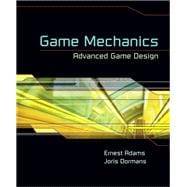
What is included with this book?
| Introduction | p. xi |
| Who Is This Book For? | p. xii |
| How Is This Book Organized? | p. xii |
| Companion Website | p. xiii |
| Designing Game Mechanics | p. 1 |
| Rules Define Games | p. 1 |
| Discrete Mechanics vs. Continuous Mechanics | p. 9 |
| Mechanics and the Game Design Process | p. 12 |
| Prototyping Techniques | p. 15 |
| Summary | p. 21 |
| Exercises | p. 22 |
| Emergence and Progression | p. 23 |
| The History of Emergence and Progression | p. 23 |
| Comparing Emergence and Progression | p. 24 |
| Games of Emergence | p. 26 |
| Games of Progression | p. 30 |
| Structural Differences | p. 37 |
| Emergence and Progression Integration | p. 39 |
| Summary | p. 41 |
| Exercise | p. 42 |
| Complex Systems and the Structure of Emergence | p. 43 |
| Gameplay as an Emergent Property of Games | p. 43 |
| Structural Qualities of Complex Systems | p. 47 |
| Harnessing Emergence in Games | p. 57 |
| Summary | p. 58 |
| Exercises | p. 58 |
| Internal Economy | p. 59 |
| Elements of Internal Economies | p. 59 |
| Economic Structure | p. 62 |
| Uses for Internal Economies in Games | p. 71 |
| Summary | p. 78 |
| Exercises | p. 78 |
| Machinations | p. 79 |
| The Machinations Framework | p. 79 |
| Machinations Diagram Basic Elements | p. 82 |
| Advanced Node Types | p. 93 |
| Modeling Pac-Man | p. 98 |
| Summary | p. 104 |
| Exercises | p. 104 |
| Common Mechanisms | p. 107 |
| More Machinations Concepts | p. 107 |
| Feedback Structures in Games | p. 113 |
| Randomness vs. Emergence | p. 126 |
| Example Mechanics | p. 130 |
| Summary | p. 144 |
| Exercises | p. 145 |
| Design Patterns | p. 147 |
| Introducing Design Patterns | p. 147 |
| Machinations Design Pattern Language | p. 151 |
| Leveraging Patterns for Design | p. 168 |
| Summary | p. 169 |
| Exercises | p. 170 |
| Simulating and Balancing Games | p. 171 |
| Simulated Play Tests | p. 171 |
| Playing with Monopoly | p. 179 |
| Balancing SimWar | p. 187 |
| From Model to Game | p. 195 |
| Summary | p. 195 |
| Exercises | p. 196 |
| Building Economies | p. 197 |
| Economy-Building Games | p. 197 |
| Analyzing Caesar III | p. 199 |
| Designing Lunar Colony | p. 206 |
| Summary | p. 219 |
| Exercises | p. 220 |
| Integrating Level Design and Mechanics | p. 221 |
| From Toys to Playgrounds | p. 221 |
| Missions and Game Spaces | p. 229 |
| Learning to Play | p. 238 |
| Summary | p. 244 |
| Exercises | p. 246 |
| Progression Mechanisms | p. 247 |
| Lock-and-Key Mechanisms | p. 247 |
| Emergent Progression | p. 258 |
| Summary | p. 270 |
| Exercises | p. 270 |
| Meaningful Mechanics | p. 271 |
| Serious Games | p. 271 |
| Communication Theory | p. 276 |
| The Semiotics of Games and Simulations | p. 282 |
| Multiple Layers of Meaning | p. 294 |
| Summary | p. 299 |
| Exercises | p. 300 |
| Machinations Quick Reference | p. 301 |
| Design Pattern Library | p. 303 |
| Static Engine | p. 303 |
| Dynamic Engine | p. 305 |
| Converter Engine | p. 308 |
| Engine Building | p. 311 |
| Static Friction | p. 314 |
| Dynamic Friction | p. 316 |
| Stopping Mechanism | p. 319 |
| Attrition | p. 321 |
| Escalating Challenge | p. 325 |
| Escalating Complexity | p. 327 |
| Arms Race | p. 330 |
| Playing Style Reinforcement | p. 333 |
| Multiple Feedback | p. 336 |
| Trade | p. 336 |
| Worker Placement | p. 336 |
| Slow Cycle | p. 336 |
| Getting 5tarted with Machinations | p. 337 |
| References | p. 338 |
| Index | p. 341 |
| Table of Contents provided by Ingram. All Rights Reserved. |
The New copy of this book will include any supplemental materials advertised. Please check the title of the book to determine if it should include any access cards, study guides, lab manuals, CDs, etc.
The Used, Rental and eBook copies of this book are not guaranteed to include any supplemental materials. Typically, only the book itself is included. This is true even if the title states it includes any access cards, study guides, lab manuals, CDs, etc.